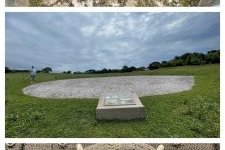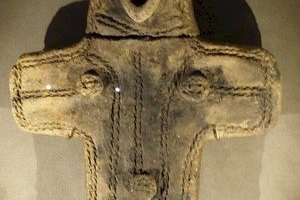Japan
Jomon Prehistoric Sites
The Jômon Prehistoric Sites in Northern Japan represent the culture of a sedentary hunter-fisher-gatherer society.
The Jomon people continuously occupied the Japanese archipelago for over 10,000 years. They did not transition to an agricultural society but continued to live off the land (nuts, berries) and the sea (shellfish) and rivers (fish). Their archeological heritage includes settlements, burial areas, ritual and ceremonial sites and artifacts such as the famous goggle-eyed dogu figurines.
Community Perspective: despite their age and obscurity, these are well-managed sites from a visitor's perspective. Els and Caspar both visited Sannai-Maruyama in Tohoku. Svein added the long-awaited review of the sites on Hokkaido …
Site Info
Official Information
- Full Name
- Jomon Prehistoric Sites in Northern Japan (ID: 1632)
- Country
- Japan
- Status
-
Inscribed 2021
Site history
History of Jomon Prehistoric Sites
- 2021: Inscribed
- Inscribed
- Type
- Cultural
- Criteria
- iii
- v
Links
- UNESCO
- whc.unesco.org
- Official
-
- jomon-japan.jp — Nomination website with practical information on the serial sites
All Links
UNESCO.org
- whc.unesco.org — whc.unesco.org/
Official Website
- jomon-japan.jp — Nomination website with practical information on the serial sites
News Article
- Aug. 28, 2025 www3.nhk.or.jp — Jomon ruins at Omori Katsuyama Stone Circle closed after sighting of bears
Community Information
- Community Category
- Archaeological site: Prehistoric
Travel Information
Recent Connections
-
Historic climate change
Over a period of more than 10,000 years…
-
Perfect Inscriptions
2021 -
Hunter-gatherers
"It attests to the emergence, developme…
Connections of Jomon Prehistoric Sites
- History
-
-
Historical Food Remains
Food remains were found in several sites, e.g. in the Goshone Site "a large number of nuts (eg. chestnut, walnut, and horse chestnut), bones of fish (eg. salmon and trout), and bones of mammals (eg. deer and wild boar) have been unearthed. Together with tools that were used to gather, process, and catch them, they bear tangible testimony to the diverse food resources at that time." (Nomination file, p. 58) -
Historic climate change
Over a period of more than 10,000 years, the Jomon people continued hunter-fisher-gatherer lifeways without changing to an agrarian culture, adapting to environmental changes such as climate warming and cooling and the corresponding marine transgression and regression. (OUV)
-
Shell Mounds (Middens)
key features, especially pit dwellings and shell middens (AB ev) -
Neolithic age
"As polished stone tools were in use in the Jōmon period, it can be placed at the Neolithic stage."See www.nippon.com
-
- Architecture
-
-
Earth Architecture
"artificial earthen mounds" (Official description) – "The 17 component parts of the nominated serial property include settlements, burial areas, and ritual and ceremonial sites that include stone circles and earthworks." (AB Ev) – For example, Component Part 013 (Kiusu Earthwork Burial Circles) (Nomination file, p. 85)
-
- World Heritage Process
-
-
Perfect Inscriptions
2021
-
- Human Activity
-
-
Hunter-gatherers
"It attests to the emergence, development, maturity and adaptability to environmental changes of a sedentary hunter-fisher-gatherer society which developed from about 13,000 BCE." (Official description)
-
- Constructions
-
-
Cycoliths (Stone circles)
"ritual places including earthworks and large stone circles reaching diameters of more than 50 metres" (Official description) Examples of this are Component Parts 010 (Komakino Stone Circle), 011 (Isedotai Stone Circles) and 012 (Oyu Stone Circles). (Nomination file, p. 68, 73, 78) -
Cemeteries
Ritual centres and cemeteries appear (four sites); and Ritual centres and cemeteries are separated (five sites). (AB ev)
-
- Timeline
-
-
Late Pleistocene
The pre-agricultural society known as the Jomon culture exploited this rich environment starting about 15,000 years ago. (AB ev)
-
- Science and Technology
-
-
Archaeological potential
Some of "the property's archaeological features" are "still unexcavated and covered with a protective layer of soil". – "The State Party indicates that while further excavations are possible, they are not considered urgent at this time. Nevertheless, in response to a question by ICOMOS, the State Party indicated in its additional information that (test) excavations are planned/ongoing at four sites in order to confirm the presence of archaeological remains. Some sites have areas set aside for future excavations". (AB Ev) -
Experimental Archaeology
"In some cases, local authorities have developed life-size interpretive models of some key features, especially pit dwellings and shell middens. These models are intended to help explain to visitors some of the authentic elements that are otherwise concealed under a protective layer of soil. While the life-size models are presented as replicas, not reconstructions, and constructed so as not to have any impact on the archaeological deposits, new technologies are nevertheless explored to help visitors visualize some of the authentic archaeological features that must remain buried." (Official description)
-
- Visiting conditions
-
-
Archaeological Site Reburial
"In general, the excavated features at the 17 components have been recorded and reburied under 30 to 200 centimetres of protective soil, with a root screen to prevent root intrusion." (AB Ev)
-
News
- www3.nhk.or.jp 08/28/2025
- Jomon ruins at Omori Katsuyama Sto…
Recent Visitors
Visitors of Jomon Prehistoric Sites
- AC
- Alex Goh
- Atila Ege
- Bill Koo
- Bill Maurmann
- Casey
- Caspar
- Celina Nanbara
- chenboada
- CugelVance
- cutecid
- Els Slots
- Errol Neo
- Fan Yibo
- henrik_hannfors
- Jon Bauer
- Kasper
- Kurt Lauer
- Lithobates
- Luis Filipe Gaspar
- Lukasz Palczewski
- Luke LOU
- MaYumin
- michaelsballard
- Morodhi
- Nihal Ege
- Patrik
- pressdm
- Randi Thomsen
- Stanislaw Warwas
- Svein Elias
- Tcchang0825
- Thomas Buechler
- Tsunami
- Westwards
- Wojciech Fedoruk
- Xiong Wei
- Xiquinho Silva
- Yongcheng Liu
- Zoë Sheng
Community Reviews
Show full reviews
Visit date(s): September 29, 30, October 1, 2024
Nearby sites on trip: We were in Shiretoko several days earlier.
Overnight locations: Eniwa, Rusutsu, Hakodate
Location(s): Some locations were accessible but unstaffed when we visited, so we did not visit all of the associated museums.
- Kiusu Earthwork Burial Circles (visited small site center, Chitose City Buried Cultural Properties Center, a few kilometres away, is closed most Sundays)
- Kitakogane (Kitakogane Site Information Center closed at 17:00) (photo of shell mound)
- Takasago Burial and Irie (visited the excellent Irie Takasago Museum between the sites)
- Ofune (visited small site center)
- Kakinoshima (Hakodate Jomon Culture Center closed at 17:00)
Travel method(s): car, foot
Travel duration: We visited the sites as we drove around Hokkaido, staying in different places as we moved around the island.
Visit duration: 1-2 hours per site
OUV: Even visiting only the Hokkaido sites gives an opportunity to see the development of sedentary communities over a span of 5000 years, in coastal and hilltop locations. Each settlement location is close to the coast, so that the bones of many sea dwelling animals were found, while being inland and high enough to offer some protection from flooding, built with grave and midden space nearby. Later sites had ritual and burial areas isolated from residences. There are many more sites in the region that were not included in the designation, so it is also possible to see Jomon artefacts in …
Keep reading 0 comments
In our July 2023 Japan quest we visited 6 of the Jomon Prehistoric Sites, 5 of them on Hokkaido. All sites visited by rental car.
As our first goal in Hokkaido was Shiretoko National Park, we “elegantly” missed the first possible Jomon Site, the Kiusu Earthwork Burial Circles. We could have visited it on the way back west, but as our route was along the southern shore of Hokkaido, we headed for Kitakogane Site as our first site.
The first thing we noticed was the huge, but totally empty parking lot. Either somebody though this site would attract a lot of people - or we arrived “out of season”. Entering the site (free of charge), we found a lush green area with some small replica buildings and several shell mounds. These mounds believed to be garbage at first, but really was burial mounds. Due to type of shells, they found out that the climate was warmer at the time and that they mostly caught fish in nets. There was also a holy place at the settlement. In addition, we found a small museum on site. As this was our first Jomon Site Museum and we found it rather informative and attractive. On display it was mostly everyday items like tools, pottery, hairpins, and combs but also pearls and figurines.
Next in line was the double site, the Irie Site, and the Takasago Burial Site. The Irie site had a slightly different approach by not showing a full …
Keep reading 0 comments
I played in May 2014 a concert in the big modern concert hall of Hachinohe. During my stay in that city for rehearsals I had plenty of spare time and there seemed very little to see in this modern town. Public transport was only marked with Japanese letters, hardly anybody spoke any English, I felt rather trapped. Unfortunately I did not know about the Korekawa Jomon Site and missed out on that. I am not sure if it existed at that time or not. But after the concert I travelled west with my hosts to Aomori city to the same site that Els has visited, Sannai-Maruyama.
This is a big modern museum complex: The outside area is impressive with several "reconstructed" buildings. At the few places where you can see original digs you see not much more the holes for pillars. Therefore there must be a lot of experienced guessing work involved in those reconstructions.
The finds inside the museum are much more 'real'. In my memory the biggest part consisted of pottery. Their pottery seems to be one of the earliest in the world and their artifacts are often very creative. This raises the questions if a people can or should be inscribed for their pottery, meaning for moveable objects. If that were true then the Mexican Olmec culture, which is a bit younger but has even more impressive artifacts including the giant head sculptures should certainly be included as well. Very close to this Museum is …
Keep reading 0 comments
I don't know what the rank of the 'Jomon sites' is among the current Japanese tentative sites. There's not really one site that jumps out from their current Tentative List, maybe one or two of the early industrial sites could be a good angle for Japan to choose. According to this report, the Tomioka Silk Mill indeed will be next (in 2014).
But you never know, so while travelling between the WHS of Hiraizumi and Shirakami-Sanchi I stopped by at one of the Jomon sites. These are a cluster of 15 prehistoric archeological sites at the northern tip of Tohoku province and the south of Hokkaido. I choose Sannai-Maruyama in Aomori city, both for its accessibility and because it seems to be the most developed location.
Directions by public transport were a bit sketchy, so I took a taxi from Aomori station to bring me some 7km to the outskirts of the city. In a true example of Japanese ways, the taxi driver with whom I had no language in common decided that I should make the best of my visit to Sannai-Maruyama and called ahead with his mobile to announce that an English speaking visitor was to arrive. He then went inside the main building with me to secure that I was given a volunteer guide that spoke English. The girls behind the desk were all very excited having a guest from 'Oranda' anyway.
So I went on to visit the site with the (at …
Keep reading 0 comments
